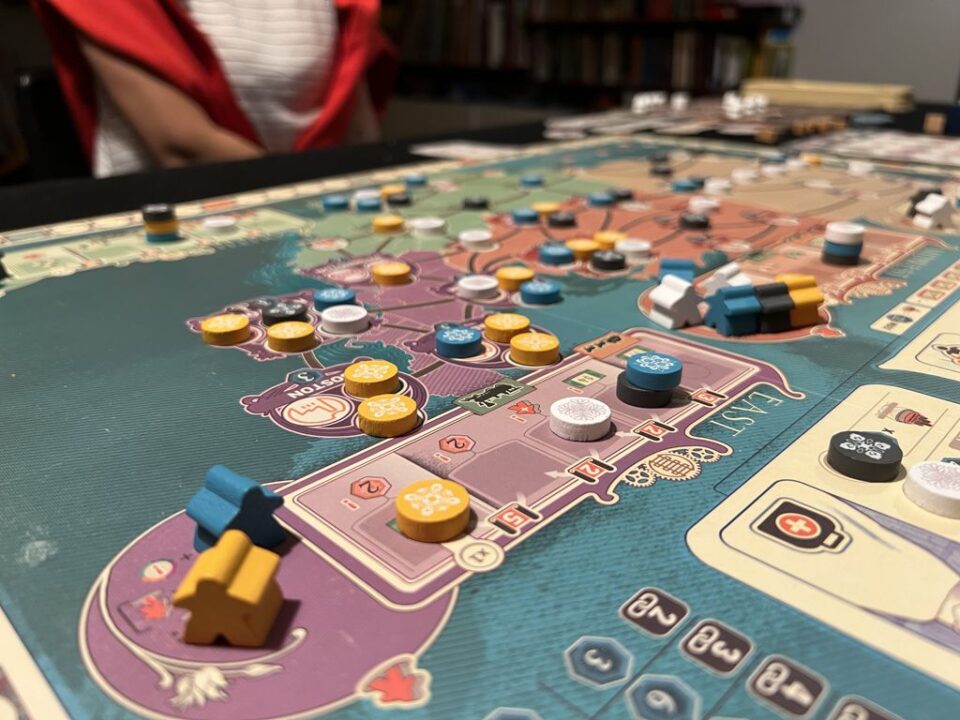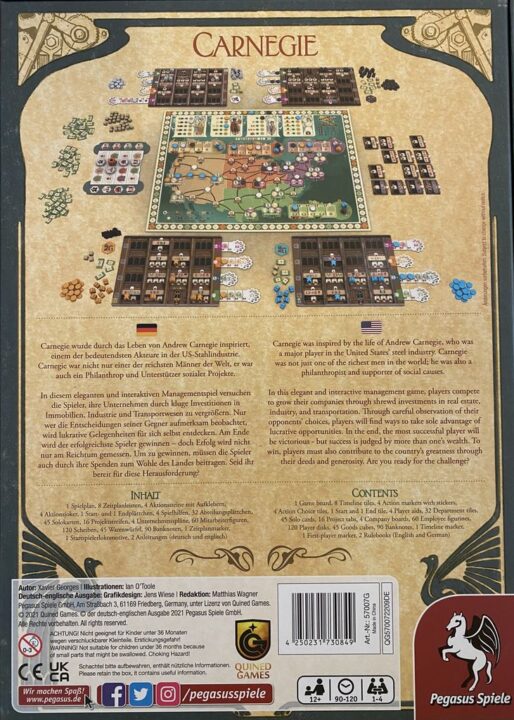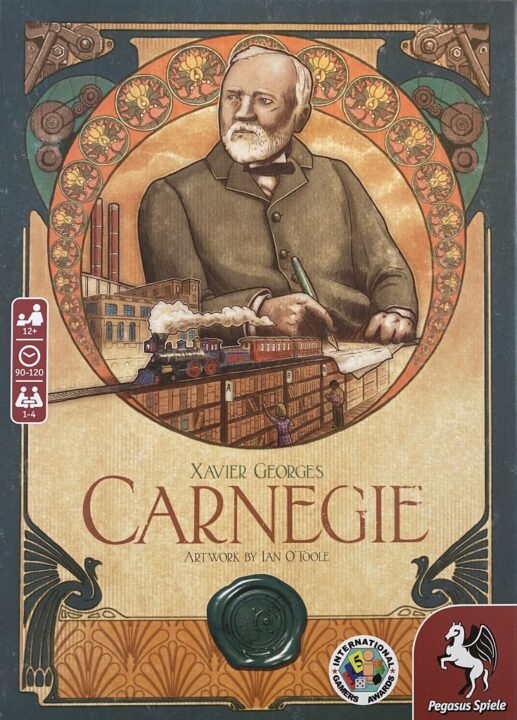Overview
Welcome to the review of Carnegie, an immersive and strategically challenging board game set in the era of the industrial revolution. In this review, we’ll delve into the captivating gameplay mechanics, stunning artwork and components, thematic immersion, and high replayability that make Carnegie a standout choice for board game enthusiasts. Join us as we explore the intricacies of this engaging game and see why it’s a must-have addition to any gaming collection.
How It Plays
Setting Up
To begin playing Carnegie, first set up the game board by placing the railway cards in a grid formation. Each player selects a color and receives a player board, influence cubes, workers, and starting resources. The industry cards and influential figure cards are shuffled and placed face-down, while the technology upgrade cards are laid out for players to choose from.
Gameplay
Carnegie is played over several rounds, with each round consisting of multiple phases. Players take turns performing actions, such as acquiring cards, constructing railways, investing in industries, and leveraging influential figures. Workers are assigned to various locations on the board to activate specific actions, while resources are managed strategically to maximize efficiency and progress towards victory.
Winning the Game
The game ends when either one player reaches the maximum level of influence on the influence track or all the industry cards have been purchased. At this point, players total their victory points, considering their railways, industries, influential figures, and completed projects. The player with the highest score emerges as the most influential tycoon of the industrial revolution and wins the game.
Want to know more? Read our extensive strategy guide for Carnegie.
Prepare for an epic game of strategy and decision-making with Carnegie! This board game offers a thrilling experience through its captivating gameplay mechanics.
1. Strategic Planning
Carnegie challenges players to think strategically and plan their every move. With multiple paths to victory, players must carefully consider their resources, investments, and actions to outsmart their opponents. Whether it’s acquiring valuable assets, leveraging the power of influential figures, or building a strong network of railways, every decision counts.
Transition:
Now, let’s delve into the details of the game’s intricate mechanics and how they contribute to the overall experience.
Resource Management and Auction
One of the key gameplay elements in Carnegie is resource management. Players must carefully allocate their limited resources, such as money and influence, to secure powerful cards and assets. The game cleverly incorporates an auction system, where players bid against each other for these valuable items. This brings an element of competition and strategic decision-making, as players must balance their desire for powerful cards with their available resources.
Worker Placement
Another interesting gameplay mechanism in Carnegie is worker placement. Players can assign their workers to different locations on the game board, taking specific actions to advance their goals. Whether it’s constructing railways to expand their network, investing in industries to generate income, or gaining favor with influential figures, players need to carefully consider their options and utilize their workers efficiently.
Technology Upgrade
Carnegie features a technology upgrade system, where players can invest in advancing their technological prowess. Upgrades provide unique abilities and advantages, allowing players to gain a competitive edge. Investing in technology becomes a crucial strategic decision, as players must weigh the short-term benefits against the long-term advantages that these upgrades can provide.
Transition:
All these gameplay mechanics make Carnegie an exciting and dynamic experience. As the saying goes, “a picture is worth a thousand words,” so let’s move on to discussing the breathtaking artwork and high-quality components that make up this incredible board game.

Immersive Artwork and High-Quality Components
The artwork in Carnegie is simply stunning. The beautifully designed game board transports players to the industrial era, with intricate details reflecting the period’s architecture and landscape. The attention to detail is exceptional, and each component is carefully crafted to enhance the gameplay experience.
Illustrations and Card Design
The illustrations on the cards are vibrant and engaging, bringing the game’s theme to life. Each card showcases a different aspect of the era, such as influential figures, industries, and railways. The card design is intuitive and easy to understand, making gameplay smooth and enjoyable. The quality of the cards is top-notch, with a sturdy feel and a smooth finish that ensures durability and enhances the overall gaming experience.
Player Tokens and Railway Markers
The player tokens in Carnegie are unique and visually appealing. Each player is represented by a different color, and the tokens themselves are shaped like miniature industrial buildings, adding an immersive touch to the game. The railway markers are also well-designed, clearly indicating the routes and connections players establish throughout the game. The attention to detail in these components is remarkable and adds to the overall aesthetic appeal of Carnegie.
Game Board
The game board in Carnegie is a work of art in itself. The layout is clear and easy to navigate, displaying all the necessary information in a visually appealing manner. The board gives players a sense of the vast industrial landscape, with railways sprawling across the region and industries flourishing. The quality of the board is excellent, with a smooth finish and sturdy construction that ensures longevity.
Transition:
Now that we’ve explored the visually stunning aspects of Carnegie, it’s time to discuss how the game immerses players in its theme and provides an unforgettable gaming experience.

An Immersive Journey into the Industrial Revolution
Prepare to be transported back in time as Carnegie immerses players in the captivating theme of the industrial revolution. The game’s mechanics are intricately woven through its theme, making every decision feel connected to the historical setting.
Historical Accuracy
Carnegie stays true to its historical setting, capturing the essence of the industrial revolution with precision. From the iconic railroads connecting cities to the influential figures of the era, every aspect of the game reflects the time period. This attention to detail adds depth and authenticity to the gameplay, allowing players to feel fully immersed.
Storytelling through Gameplay
The gameplay mechanics of Carnegie are cleverly designed to tell a story. As players invest in industries, construct railways, and acquire influential figures, they get a sense of the exponential growth and development characteristic of the industrial revolution. Each decision impacts the narrative and enhances the immersive experience, creating a sense of agency for players.
Strategic Decision-Making within the Theme
Carnegie seamlessly integrates strategic decision-making within the theme of the industrial revolution. Players must carefully strategize their actions to progress in accordance with the era’s historical context. The thematic integration adds depth to the gameplay, making every decision meaningful and reinforcing the immersion.
Transition:
After experiencing the immersive journey of Carnegie, it’s time to explore the game’s replayability and discover the numerous possibilities that await players in each playthrough.

Endless Possibilities: Replayability in Carnegie
Carnegie offers a high level of replayability, providing players with endless possibilities and new challenges in each playthrough. The game’s dynamic and strategic nature ensures that no two games will ever be the same.
Multiple Paths to Victory
One of the factors that contribute to Carnegie’s replayability is the presence of multiple paths to victory. Players can pursue different strategies, focusing on different aspects of the game, such as investing in industries, acquiring influential figures, or expanding their network of railways. This variety of approaches enables players to explore different tactics and keeps the game fresh and engaging with each new session.
Variability in Cards and Upgrades
Carnegie incorporates variability through its cards and technology upgrades. The vast array of cards available in each game ensures that players will encounter different options and opportunities in each playthrough. Additionally, the technology upgrade system introduces a level of customization and unpredictability, as players can choose different upgrades in each game, strategically altering their abilities and opening up new possibilities. This variability adds depth and replayability to Carnegie, ensuring that players will want to revisit the game again and again.
Strategic Interaction between Players
Replayability in Carnegie is enhanced by the strategic interaction between players. With each new game, players face different opponents who bring their unique strategies and decision-making to the table. This provides a fresh challenge and further adds to the game’s replay value. The dynamic nature of player interaction ensures that no game is predictable, making each session a unique and thrilling experience.
Transition:
All these factors combine to make Carnegie a highly replayable and engaging board game. Its multiple paths to victory, variability in cards and upgrades, and strategic player interaction create a game that is never stagnant and always offers something new.
I highly recommend Carnegie for fans of strategic board games who crave an immersive experience. The game’s captivating gameplay mechanics, stunning artwork, thematic immersion, and excellent replayability make it an exceptional addition to any board game collection. Prepare to embark on an unforgettable journey through the industrial revolution!
Conclusion
In conclusion, Carnegie is a fantastic board game that seamlessly combines captivating gameplay mechanics, immersive artwork and components, thematic immersion, and high replayability. With its strategic decision-making, multiple paths to victory, and dynamic player interaction, each playthrough of Carnegie is a unique and engaging experience. The stunning artwork and high-quality components enhance the overall aesthetic appeal. Whether you’re a fan of strategy games or interested in the industrial revolution, Carnegie is a game that will keep you coming back for more. It’s time to embark on this thrilling journey and become the most influential tycoon of the industrial era. This concludes the review of Carnegie.

